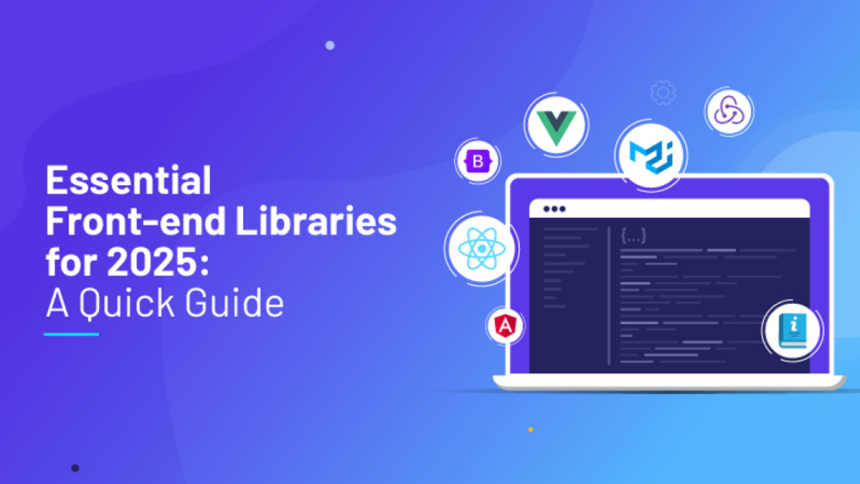As we approach 2025, the front-end development landscape is evolving rapidly, with new tools and libraries shaping how we build user interfaces. Staying up to date with the latest front-end libraries is crucial for developers who want to create seamless, responsive, and efficient web applications. Whether you’re building interactive websites, enhancing user experiences, or optimizing performance, having the right libraries in your toolkit can make all the difference.
For businesses looking to hire front-end developers, understanding the essential libraries of 2025 is key to ensuring your team stays ahead of the curve. From popular frameworks that simplify development to tools that enhance productivity and performance, the right libraries help developers work smarter and faster. In this guide, we’ll explore the must-know front-end libraries that will dominate the industry in 2025 and how they can benefit your projects.
JavaScript Libraries
JavaScript libraries simplify the creation of dynamic and interactive web applications. They are the base of modern web development, offering pre-built functions and tools for developers. These libraries are essential for building scalable, maintainable front-end architectures.
1. React
React is a popular JavaScript library developed by Facebook. It is extensively used for building user interfaces, especially single-page applications (SPAs). React is widely known for its flexibility and excellent performance.
Key Features:
- Component-based Architecture: React uses reusable components, allowing developers to create modular code. This makes development faster and easier to maintain.
- Virtual DOM: React uses a virtual DOM to update only the parts of the app that need changes. This boosts performance by making rendering more efficient.
- Strong Ecosystem: React’s vast ecosystem includes tools like React Native, which lets developers build mobile apps using the same code, saving time and effort.
2025 Relevance: Recent updates, like React 18, bring much-needed new features, such as concurrent rendering, React Server Components, and advanced hooks. These will not only improve performance and responsiveness but also help maintain React as one of the leading tools in 2025.
2. Angular
Angular is a full-featured front-end framework maintained by Google. It’s designed to build dynamic web apps, especially single-page and enterprise-level solutions. It offers adequate features right out of the box to create complex applications easily.
Key Features:
- TypeScript-based: Angular uses TypeScript, a JavaScript extension that makes code easier to debug and more predictable.
- Two-way Data Binding: Angular automatically syncs the data and UI, updating both without extra code. This is helpful for apps with a lot of data or user input.
- Comprehensive Framework: Angular includes built-in tools like routing, form handling, and HTTP services, making it a one-stop solution for building large applications.
2025 Relevance: In 2025, Angular will remain a top choice for large apps with complex needs. New features like StandAlone Components and better performance optimizations will make it even more powerful and efficient.
3. Vue.js
Vue.js is a lightweight JavaScript framework for building user interfaces. It’s flexible, making it ideal for both small apps and large, complex projects.
Key Features:
- Reactive Two-way Data Binding: Like Angular, Vue.js syncs data and UI in real-time, making it easy to manage apps with lots of user input.
- Strong Ecosystem: Tools like Vue Router and Vuex simplify handling navigation and state management, even for large apps.
- Easy Learning Curve: Vue.js is simple to learn. You can quickly start building with Vue if you know HTML, CSS, and JavaScript. It scales well for both small and big apps.
2025 Relevance: Vue.js will continue to evolve and introduce helpful features, such as Composition API, to help developers easily manage complex apps. Thus, due to its performance improvements and flexibility, it will remain among the top choices for startups and large-scale projects.
CSS Frameworks and Preprocessors
CSS frameworks and preprocessors simplify and speed up the development process. These tools provide pre-built styles and components, making it easier for developers to create consistent and maintainable user interfaces without writing CSS from scratch.
4. Bootstrap
Bootstrap, originally Twitter Blueprint, is the most popular CSS framework for building responsive websites. It is known for its ease of use and flexibility. Bootstrap helps developers create websites that work well on all devices, from mobile to desktop.
Key Features:
- Pre-built Components: Bootstrap has many ready-to-use UI components like buttons, forms, and navigation bars. Its responsive grid system makes designing layouts for different screen sizes simple.
- Great Documentation: Bootstrap’s documentation is clear and easy to follow, making it accessible to beginners. Plus, its large community offers many tutorials and third-party themes.
- Sass Integration: With Sass, developers can customize Bootstrap easily by changing colors, fonts, and more, making it flexible for unique design needs.
2025 Relevance: The latest version, Bootstrap 5, focuses on speed, accessibility, and modern tools. Thus, Bootstrap continues to be a top choice for fast, mobile-first design.
5. Material UI
Material UI is a popular React component library based on Google’s Material Design. It helps developers quickly build clean, modern user interfaces for web applications. Designed for React, it integrates smoothly into projects, making it a go-to choice for creating visually consistent apps.
Key Features:
- Pre-designed Components: Material UI offers ready-made components like buttons, forms, and menus. These follow Google’s Material Design guidelines to ensure a consistent look and feel across different devices.
- Custom Themes: Material UI’s theming system allows you to customize colors, fonts, and layouts easily. This includes seamless switching between light and dark modes.
- Modern Design: Built on Google’s design principles, Material UI ensures a polished and professional look, perfect for seamless user experiences.
2025 Relevance: Material UI will remain a top choice for developers for fast, visually appealing React apps. Its Dark Mode support and performance improvements keep it efficient and user-friendly.
6. Sass
Sass (Syntactically Awesome Stylesheets) is a powerful CSS preprocessor that helps developers write more organized and scalable stylesheets. It adds features like variables, nesting, and mixins to regular CSS, making it easier to manage complex projects.
Key Features:
- Modular CSS: Sass lets you split styles into smaller files and import them into one main stylesheet. This keeps your code clean and manageable, especially in large projects.
- Reusable Code: With mixins and functions, you can reuse styles and avoid repeating code. This ensures consistency and reduces the time spent on updating styles.
- Framework Compatibility: Sass works seamlessly with popular frameworks like Bootstrap, allowing developers to customize designs without writing extra CSS.
2025 Relevance: In 2025, Sass will remain a must-have for developers. Its ability to organize and scale stylesheets makes it ideal for large projects. Sass also keeps evolving, making it compatible with modern CSS features, ensuring developers stay efficient and up to date.
State Management
State management in front-end development is crucial in modern web applications, especially those with complex data flows and multiple components. Managing the application state efficiently ensures that data remains consistent and accessible across different app parts. Proper state management tools help developers avoid issues like state duplication, unpredictable behavior, and excessive re-renders.
7. Redux
Redux is a popular state management library mainly used with React. It simplifies managing an app’s global state, making updates predictable and easy to debug. While often paired with React, it works with other frameworks, too.
Key Features:
- Centralized State: Redux stores the entire state in one place, making updates clear and consistent across the app. This structure is great for larger projects with lots of data.
- Middleware for Async Actions: Redux handles async tasks like API calls with middleware like Redux Thunk. This keeps the main code clean while managing side effects.
- DevTools for Debugging: Redux DevTools lets you track every action, check the current state, and even “time travel” to fix bugs.
2025 Relevance: Redux will remain essential for complex apps in 2025. Its structure and tools, like the Redux Toolkit, simplify managing large-scale projects and keep code clean and maintainable.
8. Context API (React)
The Context API is a built-in React feature for managing the global state without prop drilling. It lets you pass data through the component tree, making state management easier, especially for small to mid-size projects.
Key Features:
- Simple State Management: The Context API is great for managing state without requiring Redux or external libraries. It’s built into React, making it a lightweight solution for passing data between components.
- No Extra Libraries Needed: Since it’s part of React, there’s no need to install additional tools or middleware. You can use it immediately, keeping the development process clean and simple.
- Works with Hooks: The API integrates well with React’s hooks, such as using Context, useContext, and Reducer, letting you handle more complex state logic without the overhead of Redux.
2025 Relevance: In 2025, Context API will still be a go-to choice for small apps needing easy, no-fuss state management. It handles simple tasks like theme settings or user data sharing.
Testing Libraries
Testing libraries ensure web application stability, reliability, and performance. These libraries allow developers to write automated tests that verify the functionality of their code, detect bugs, and prevent regressions.
9. Jest
Jest is a popular testing framework for JavaScript created by Facebook. It’s great for React apps and works with other JavaScript frameworks, too. Jest is known for being easy to use and packed with features.
Key Features:
- Snapshot Testing: Jest’s snapshot feature helps ensure your UI stays consistent. It takes a “snapshot” of a component’s output and compares it to future renders. If anything changes, Jest lets you know, which is super helpful for keeping your UI looking the same.
- Mocking Made Easy: Jest makes mock functions or modules simple, which is handy for testing without real dependencies like APIs. It requires little setup, making it easy to start testing right away.
- Fast and Efficient: Jest runs tests in parallel, speeding up large test suites. It also provides built-in code coverage to show how much your code is being tested.
2025 Relevance: Jest’s TypeScript support and fast performance make it a top choice for developers. Thus, it will remain a key for testing React apps.
10. Cypress
Cypress is a powerful end-to-end testing tool. It runs tests directly in the browser, giving real-time feedback. It works seamlessly with JavaScript frameworks like React, Vue.js, and Angular, making it a favorite for front-end developers.
Key Features:
- Time Travel Debugging: Cypress lets developers review their tests and see the app’s state at each stage. It takes snapshots during test runs, making it easy to spot errors without rerunning the test.
- Fast, Reliable Tests: Because Cypress runs directly in the browser, it mimics real user actions and speeds up testing. Developers can see the app’s behavior as tests run, speeding up bug detection.
- Automatic Waiting: Cypress automatically waits for DOM elements to load before running actions, reducing flaky tests. This makes tests more stable and less prone to false positives.
2025 Relevance: In 2025, Cypress will still be a top choice for fast, reliable testing. With growing support for component testing and cross-browser compatibility, it’s set to remain essential for modern web development.
11. Mocha
Mocha is a flexible testing framework for JavaScript. It works well with both Node.js and browser environments. Developers use it to test everything from simple functions to complex async operations.
Key Features:
- Asynchronous Testing with Hooks: Mocha handles asynchronous testing easily, which is key for modern apps. It has hooks like before and after that let developers set up and clean up before and after tests. This ensures tests run smoothly without affecting each other.
- Customizable with Popular Libraries: Mocha doesn’t have a built-in assertion library, but it works great with others like Chai and Sinon. This lets developers choose how they want to write and organize tests. Mocha is also highly customizable, especially when generating detailed test reports.
- Works with Other Tools: Mocha’s flexible design makes integrating tools like Chai for assertions and Sinon for spies and mocks easy. This makes Mocha ideal for building tailored test suites.
2025 Relevance: In 2025, Mocha will still be essential for JavaScript testing, offering unmatched flexibility for complex testing needs.
Build Tools
Build tools play a critical role in front-end development by automating bundling, minification, and optimization tasks. These tools streamline code preparation for production environments. Thus, it helps developers manage complex workflows, ensure better performance, and improve the overall development process.
12. WebPack
Webpack is a popular open-source module bundler for JavaScript and other assets like CSS, images, and fonts. It helps developers pack everything into optimized files that load faster in the browser.
Key Features:
- Modular Bundling: Webpack bundles all the assets in your project into one or more files, improving load times and reducing server requests. It handles JavaScript, CSS, images, and more, making it a versatile tool for managing all your resources.
- Tree-shaking and Code-splitting: These features help remove unused code and break your app into smaller chunks. This speeds up the performance, making the app more responsive by loading only the necessary parts.
- Extensible with Plugins: Webpack allows developers to add custom functionality through plugins, like Babel, for transpiling or tools to optimize images. This flexibility makes it suitable for both small and large projects.
2025 Relevance: In 2025, Webpack will still be key for large projects, especially with its performance boosts and support for modern technologies. Its efficiency and ease of use will keep it a top choice for developers.
13. Parcel
Parcel is a zero-configuration build tool designed for fast and easy bundling. It’s perfect for developers who want to focus on coding without worrying about setup. Whether for small projects or rapid prototyping, Parcel simplifies the development process.
Key Features:
- Auto-bundling Without Configuration: Parcel automatically bundles JavaScript, CSS, and images without a config file. You can jump straight into coding, and Parcel will optimize everything in the background, saving you time.
- Fast Hot Module Replacement (HMR): With HMR, Parcel updates only the changed module in real-time without refreshing the whole page. This speeds up testing and debugging.
- Built-in ES6 Module Support: Parcel natively supports ES6 modules, so you can use modern JavaScript without extra setup. It ensures compatibility with older browsers through automatic transpilation.
2025 Relevance: In 2025, Parcel will remain a top choice for fast and simple projects, from startups to personal apps. It continues evolving to handle larger projects while maintaining its zero-configuration ease.
14. Rollup
Rollup is a module bundler designed for building small, fast JavaScript libraries. It’s perfect for projects where performance and simplicity matter most, especially for shared libraries and frameworks.
Key Features:
- ES6 Module Support: Rollup focuses on ES6 modules, letting you create smaller, optimized bundles. This makes your code run faster in modern browsers.
- Tree-shaking: Rollup automatically removes unused code, making your final file smaller and quicker to load. It helps improve both performance and user experience.
- Simple Configuration: Rollup is easy to set up and ideal for smaller projects or libraries. It provides an efficient build tool without requiring much configuration.
2025 Relevance: In 2025, Rollup will still be a top choice for developers creating libraries or small apps. Its focus on minimal, efficient bundles and easy setup makes it essential for those wanting to deliver fast, reliable code.
Conclusion
In 2025, front-end libraries will be key for developers aiming for faster, scalable, and efficient web apps. Tools like React, Bootstrap, and Webpack help simplify complex workflows and speed up development. Choosing the right tool for your project—large or small—ensures smooth performance and better code maintenance.
As new trends like AI-assisted coding and performance optimization take off, staying updated with the latest tools will be crucial. Explore different libraries to find the best fit for your project, and you’ll be ready to build dynamic, future-proof applications with ease.
Lynn Martelli is an editor at Readability. She received her MFA in Creative Writing from Antioch University and has worked as an editor for over 10 years. Lynn has edited a wide variety of books, including fiction, non-fiction, memoirs, and more. In her free time, Lynn enjoys reading, writing, and spending time with her family and friends.














